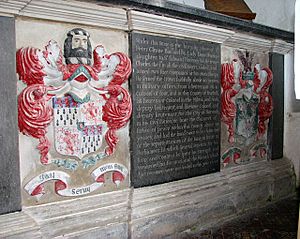Sir Peter Gleane, 1st Baronet facts for kids
Sir Peter Gleane, 1st Baronet (born around 1619, died 7 February 1696) was an important person from a wealthy family in East Anglia, England. He was also a member of the Parliament of England, which is like being a politician in today's government.
Contents
Early Life and Family
Sir Peter Gleane was born in 1619. He was the oldest son of Thomas Gleane and Elizabeth Brewse. His family had been important merchants in Norwich for a long time.
His great-grandfather bought a large estate called Hardwick in Norfolk. This became the family's main home. Sir Peter's grandfather, also named Peter, was a Member of Parliament for Norwich from 1628 to 1629.
Serving the King and Country
During the English Civil War, Sir Peter Gleane supported the King. He raised two groups of soldiers, called foot companies, at his own cost. He served as a Lieutenant of Foot around 1643. He might have become a Captain by 1645.
After the war, during a time called the Protectorate, people still thought he supported the King. Around 1650, he married Penelope Rodney. They had two sons and one daughter.
When the King returned to power in 1660, Sir Peter became a major in the local army. He also became a lieutenant in a group of volunteer horsemen. The next year, he took over his father's estate. He also helped officers who had been loyal to the King but were now poor.
Becoming a Baronet
On March 6, 1666, Sir Peter was given the title of Baronet. This happened during the 2nd Anglo-Dutch War. In this war, he was a Lieutenant Colonel in a foot regiment. He was second-in-command to Lord Townshend. Sir Peter helped lead the defense of Great Yarmouth during the war.
In 1675, he became a commissioner for people who did not follow the official Church of England. However, he and Lord Townshend were removed from their local jobs in 1676.
In Parliament
During a time called the Exclusion Crisis, Sir Peter Gleane strongly believed that James, Duke of York should not become king. This was because James was Roman Catholic.
In 1679, Sir Peter ran for Parliament in Norfolk. He ran with Sir John Hobart. They won the election, beating the candidates who supported King Charles II.
After winning, Sir Peter gave a speech. He promised to serve the King, the Church of England, and his country. Some people who voted for him were not happy with this speech. They thought he might change his mind later.
Sir Peter was part of five committees in Parliament. He was elected again in 1681. However, this second election cost him a lot of money.
Later Life and Challenges
By 1682, Sir Peter's money problems were very serious. He even built his own tomb in the church at Hardwick. He was never buried there, though. The tomb has words carved on it that say:
He served the crown faithfully above 40 years in military offices. ... In his civil status he bore the character of a justice of the peace within this county above 20 years, and had the honour twice to be chosen one of the representatives of the same to serve in Parliament, in which several services for his King and country he spent his strength and fortunes, and the wounds which that [sic] received were not healed in the year 1683.
In 1686, he was pressured to pay a large fee for his Baronet title. But Laurence Hyde, a powerful government official, stopped this.
Before he died, his money problems were so bad that he had to sell his family home, Hardwick, to Sir John Holland. His oldest son even had to live on a small payment from the county. This payment was later stopped, and his son was sent to prison because of debt.
Sir Peter Gleane died in 1694. He was buried at Hardwick. His oldest son, Thomas, became the next Baronet.


